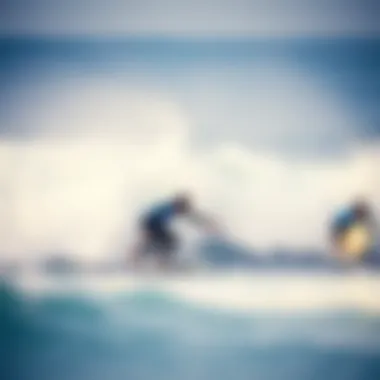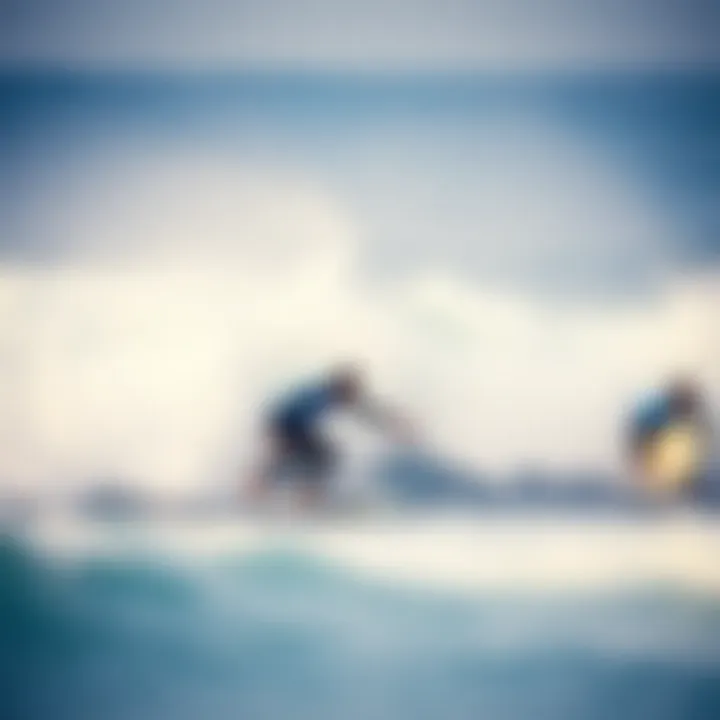Mastering the Surfing Drop In: Key Techniques and Etiquette


Intro
When it comes to the world of surfing, few moments are as exhilarating as the drop in. This critical maneuver not only sets the tone for your ride but also plays a fundamental role in the dynamics of wave interaction. Understanding the drop in transcends mere technicality; it weaves into the broader narrative of respect and etiquette that governs surfers in the lineup.
A drop in occurs when a surfer catches a wave that another surfer is already riding. This action can make or break your session. Thus, it's essential to grasp its mechanics, implications, and the unspoken rules that guide this thrilling aspect of surfing.
In this guide, we will unpack the techniques to master the drop in, discuss the mindset needed, and navigate the nuances of etiquette that form the backbone of surf culture. Whether you're a newbie just dipping your toes into the water or a seasoned rider looking to polish your skills, this article will offer valuable insights to enhance your experience in the surf.
Tips and Techniques
Beginner Tips for Watersports
Getting comfortable with the drop in starts even before you hit the water. Here are some essential tips that every beginner should consider:
- Choose the right wave: Begin by understanding which waves are suitable for your skill level. Smaller waves with gentle peaks can be less intimidating as you learn.
- Positioning is Key: Always position yourself behind the breaking part of the wave. Being in the right spot gives you the best chance to catch it without crashing into someone else.
- Observe and Learn: Spend some time just watching more experienced surfers. Notice how they navigate the waves and respect the lineup. Copying their body movements and drop-in styles can be instructive.
- Focus on Balance: Before dropping in, practice your balance on the board while paddling. Good balance will help you maintain control as you ride the wave.
Advanced Techniques for Mastery
For those who have mastered the basics and are ready to amp up their drop-in game, here are some advanced techniques:
- Angle Your Approach: Instead of dropping straight down, angle your board slightly, which allows for a smoother entry into the wave's energy.
- Commit Fully: Half-hearted drops often lead to wipeouts. Once you decide to drop in, commit to it fully. This involves leaning forward and adjusting your body weight appropriately.
- Anticipate Wave Movement: Each wave's energy is unique. Advanced surfers can read the wave's movement, which allows them to time their drop in perfectly.
- Use Your Arms: As you drop in, arm placement can affect your balance. Position your arms wide for stability or keep them in to slice through the water efficiently and gain speed.
"Mastering the drop-in is like learning a dance with the ocean. Each move counts, and respecting your fellow dancers keeps the rhythm flowing."
Safety and Gear
Essential Safety Practices
Staying safe in the water is paramount, especially when practicing your drop-in technique. Here are some safety practices to keep in mind:
- Wear a Leash: Ensure you have a properly secured leash to prevent your board from getting away from you during a wipeout. This not only saves your board but also helps protect others.
- Know the Surf Spot: Research the area you'll be surfing in. Familiarize yourself with tidal changes, currents, and any hazardous underwater terrain.
- In Case of a Wipeout: If you happen to wipe out, try to fall flat and avoid hitting your board. Protect your head with your arms.
Gear Reviews and Recommendations
Choosing the right gear enhances not only your performance but also your experience. A few recommended items include:
- Surfboards: Consider a longboard like the a href="https://www.jimbodolls.com" target="_blank">Soft Top Funboarda> for beginners, as it offers more stability. Advanced surfers might opt for a shortboard designed for speed and maneuverability.
- Wetsuit: Depending on your surfing location and temperature, a reliable wetsuit from brands like a href="https://www.quiksilver.com" target="_blank">Quiksilvera> or a href="https://www.o'neill.com" target="_blank">O'Neilla> can provide the necessary insulation.
- Leash: Pick a leash that’s the right length for your board and strong enough for your surfing style. Brands like a href="https://www.surflogic.com" target="_blank">SurfLogica> offer a variety of options.
Intro to the Drop In
In the dynamic world of surfing, the concept of a "drop in" can be both thrilling and daunting for surfers of all skill levels. This technique is not just an action; it embodies the very rhythm and etiquette that govern the surfing community. Understanding the drop in is essential, as it holds the power to either enhance or disrupt the flow of the surf experience for all involved.
Defining the Drop In
A drop in occurs when a surfer paddles into a wave that another surfer is already riding, effectively taking their spot. This maneuver is often regarded with varying degrees of acceptance and can lead to conflict if not executed thoughtfully. In most cases, there are unspoken rules about who has the right of way on a wave, making the drop in a delicate operation. By clearly defining this action, surfers can appreciate the stakes involved. It's a balance between seizing an opportunity and respecting the precedence established by others. Failure to navigate this balancing act can lead to collisions, misunderstandings, and a negative surfing experience.
Historical Context
The drop in has evolved significantly since the early days of surfing on the Hawaiian Islands. Initially, the concept was less about competition and more about camaraderie among surfers riding the same waves. As the sport grew in popularity, particularly in the 20th century, the influx of surfers led to a more complex wave dynamic and a desperate need for rules to ensure a harmonious experience.
The rise of surf culture, fueled by movies and surfing heroes in the 1960s, brought about a more competitive spirit, which arguably intensified the urgency of executing a proper drop in. Today, surfers everywhere, from the beaches of California to the shores of Australia, grapple with the same ethos. The drop in is not merely a technique; it’s a practice steeped in tradition and respect for the exhilarating yet unpredictable nature of the ocean.
In summary, understanding the drop in is more than a basic surfing skill; it's a lesson in respect, history, and the spirit of community that influences surf culture today. Comprehending this concept equips surfers, both seasoned and novice, with the skills to navigate waves thoughtfully, ensuring a safer and more enjoyable experience for everyone.
"Surfing is not just a sport; it's a way of life that brings together people who share a passion for the waves."
In the sections to follow, we will delve into the mechanics, etiquette, and techniques associated with drop ins, providing a comprehensive guide for surfers looking to master this essential skill.
The Mechanics of a Drop In
Understanding the mechanics of a drop in is crucial for surfers at all levels. This section sheds light on the specific elements that contribute to executing a successful drop in while emphasizing the impact of wave dynamics, positioning, and timing.
Understanding Wave Dynamics
Wave dynamics refer to the interplay of various forces acting on waves as they approach the shore. This knowledge is fundamental for anyone looking to master the drop in. The energy of the wave, its height, and the angle at which it breaks significantly influence a surfer's ability to execute a clean entry.
- Types of Waves: Different waves, such as beach breaks or point breaks, behave in unique ways. For example, a steep beach break offers a fast drop in, requiring quick reflexes, while a gradual point break allows for more anticipation.
- Wave Shape and Break: Recognizing whether a wave is peaky, mushy, or hollow impacts how you should approach your drop in. A peaky wave could mean a quick drop followed by a fast ride, while a mushy wave may require a more gradual approach.
Understanding these dynamics allows surfers to predict wave behavior better and prepare appropriately, which is essential for reducing the risk of mishaps and ensuring a more enjoyable ride.
Positioning on the Wave
The way a surfer positions themselves on the wave is pivotal for successfully dropping in. Correct positioning can be the difference between smoothly carving down the face of the wave and wiping out spectacularly. Key aspects to consider include:
- Placement on the Board: Surfers should find the right spot on their board, maintaining a balance that lets them control their descent. Generally, leaning slightly forward might propel a surfer down the wave, while too far back results in losing momentum.
- Angle of Entry: The angle at which a surfer initiates their drop can affect their trajectory. Entering too steeply might put a surfer in danger of falling, whereas a balanced angle can lead into a ride.
Effective positioning forms the backbone of a skilled drop in, allowing surfers to manage their speed and maintain stability as they move into the wave.


Timing and Execution
While positioning sets the stage for a drop in, timing dictates the performance. The right timing can enhance a surfer’s experience by ensuring that they catch the wave at the optimum moment.
- Assessing the Wave: Surfers must carefully watch the sets and identify when to drop in. The moment the wave begins to peak is often the best opportunity for a drop into the wave’s rolling face.
- Physical Execution: When the correct moment arrives, the execution entails shifting weight forward while angling the board down the face of the wave. This movement requires a precise blend of balance, strength, and control. Immediate adjustments are needed to navigate any unexpected shifts in wave dynamics.
Getting this timing right will help in launching into the optimal trajectory, allowing for a smoother entry into the surf, and ultimately enhancing the overall experience.
"Great moves are made when surfers respect the wave and stay tuned in to its rhythm."
Grasping the mechanics involved in dropping in typically serves as a launching point for all surfers, granting them the tools needed to refine their approach and hone their skills in the water. Without these foundational understandings, progressing in surfing can become a steep hill to climb. Knowledge of wave dynamics, proper positioning, and impeccable timing are essential for mastering the art of drop ins.
Etiquette Around Drop Ins
Understanding the etiquette surrounding drop-ins in surfing is crucial—not just for personal success on the water, but for maintaining the overall harmony of the lineup. Surfing is as much about respect and community as it is about skill. Failure to adhere to proper etiquette can lead to dangerous situations and alter the vibe at your local spot. In this section, we will examine the importance of courtesy in surfing, focusing on two main facets: respecting locals and grasping the right of way.
Respecting Locals and Surf Culture
One of the unspoken rules in surfing is the need to respect locals and, by extension, the surf culture they represent. Every surf break has its own community, often tied deeply to the area’s history and culture. When you drop in on a wave at a local beach, it’s more than just a wave to those who frequent it; it symbolizes their connection to their environment. Locals often have a better understanding of wave conditions and timing, which adds layers of significance to an already complex interaction.
When visiting a new surf spot, take a moment to observe the dynamics at play. Be aware of who’s riding particular waves and the general flow of the session. By showing respect, you’re adhering to an unspoken agreement that maintains goodwill among surfers. Here are some ways to demonstrate respect to locals:
- Greet surfers before paddling out: A simple nod or a warm smile can break the ice and set a welcoming tone.
- Pay attention to the pecking order: This often means observing who’s established in the water and gauging their comfort level with you.
- Avoid crowded lineups for the first few visits: If there’s a beach nearby with fewer people, consider honing your drop-in skills in a less pressured environment before tackling the locals.
Taking these steps helps foster positive interactions and can make your experience more enjoyable, allowing you to integrate into the surfing community rather than being seen as an outsider.
The Right of Way
The right of way in surfing can be likened to traffic rules on land; they’re vital for maintaining order and safety in the lineup. The basic principle is straightforward: the surfer closest to the peak of a wave typically has priority. Yet, things get murky when new surfers enter the mix or when the waves start to roll in fast and furious.
Here’s what you need to know if you want to navigate the right of way like a pro:
- Know the pecking order: As a rule of thumb, once a surfer starts to drop in on a wave, anyone further inside that line must yield, allowing them to carve their path.
- Pay attention to the wave's takeoff zone: If someone is already paddling hard toward the peak, it's best to refrain from trying to drop in, regardless of the surfer's skill level.
- Communicate when necessary: A simple shout or hand signal can clarify intentions before things get tense.
"Surfing teaches us that the ocean is not just a playground; it's a community where respect is the glue that binds us together."
Notably, bad manners while surfing can escalate quickly. Take the time to learn and respect the unwritten rules of the water. When you exhibit good sportsmanship, you not only enhance your surfing experience but also contribute to a more enjoyable environment for everyone involved.
In summary, understanding and practicing the etiquette around drop-ins is essential for any surfer looking to navigate crowded waters safely. Respecting locals and adhering to right of way protocols not only prevents accidents but also fosters community spirit. Surfing transcends just the act of riding waves; it's about connecting with others who share the same passion.
Common Misunderstandings
It's easy to fall into the trap of misconceptions when it comes to surfing drop ins. These misunderstandings can not only hinder your own performance but also disrupt the harmony of the lineup. Understanding the roots and nuances of these misconceptions is vital for every surfer who wants to ride in a shared environment. This section will clarify some critical misunderstandings surrounding drop ins, focusing on etiquette and skill execution.
Mistaking Drop Ins for Priority
One of the biggest misconceptions is equating a drop in with priority. New surfers often believe that simply dropping in on a wave signifies they have the right of way. This is a dangerous belief. A drop in means taking a wave that another surfer is already riding, and it can lead to conflicts on the water. Understanding right of way is crucial in maintaining respect and safety among surfers.
Each surf spot has its unwritten rules, and it’s common for locals to get frustrated with anyone who doesn’t adhere to them. Riders need to recognize that dropping in does not automatically give them priority over other surfers. Here’s how to navigate it:
- Watch carefully: Before dropping in, observe who is already on the wave. The surfer who is closest to the peak usually has the right of way.
- Communicate: If necessary, signal your intention to drop in. A simple wave or nod can sometimes clear misunderstandings.
- Seek Guidance: If you’re unfamiliar with an area, ask local surfers or instructors about the specific rules of that surf spot. A bit of humility goes a long way in earning respect.
Aggressive Behaviors and Their Impact
Another significant issue related to drop ins is aggressive behavior. Some surfers react defensively if they feel their wave has been taken away. This hostility can escalate quickly, creating an environment where both safety and enjoyment are compromised.
Aggressive behaviors manifest in various forms, such as:
- Yelling and insulting: Some surfers might shout at those who drop in. This not only intimidates the offender but also creates tension in the lineup.
- Paddling aggressively: Returning to the lineup, some surfers might paddle right through others, further causing a ruckus.
- Confrontations: In extreme cases, aggressive surfers may confront one another on land or in the water, leading to unsafe scenarios.
These aggressive reactions can sour the overall surfing experience, making camaraderie difficult to achieve. Here’s how to handle things better:
- Remain Calm: If someone drops in, take it in stride. Staying cool-headed helps maintain the peace in the lineup.
- Conflict Resolution: If you've been in a situation where a wave was taken, discuss it calmly after the session. This could lead to mutual understanding.
By avoiding misunderstandings about drop ins and steering clear of aggressive behaviors, surfers can foster a more enjoyable and respectful atmosphere in the water. Ultimately, surfing should be about sharing waves and enjoying the ride, not about conflict and confrontation.
Techniques for Successful Drop Ins
Understanding the techniques for successful drop-ins is crucial for anyone serious about surfing. The drop-in is not just a maneuver; it’s a blend of finesse and timing, embodying the essence of surfing culture. When executed correctly, it allows surfers to harness the power of the wave, making their ride smoother and more exhilarating. However, mastering these techniques requires patience, observation, and practice.
Analyzing Wave Patterns
Before even considering a drop-in, it’s vital to analyze the wave patterns. Each wave behaves differently depending on various factors such as wind direction, tide, and current. Recognizing these patterns can mean the difference between a triumphant ride and a disastrous wipeout. Here are some aspects to focus on:
- Wave Break Location: Identify where the wave starts to break. This will help you understand the right moment to paddle for a drop-in.
- Wave Size and Shape: Bigger waves often come with more power. A steep face might seem inviting but requires skill to navigate. Observing how waves peel can inform your approach.
- Surfer Traffic: Pay attention not just to the waves but to where other surfers are positioned. This can help you gauge when to safely drop in without infringing on someone's ride.
An effective way to analyze is to spend time just watching the water before paddling out. Observe not just the waves but the surfers too. Patterns emerge over time, enhancing your intuition for those pivotal moments.
Adjusting Stance and Balance


Once you have a handle on the wave conditions, it’s time to focus on your stance and balance. Your body position plays a massive role in how well you manage your drop-in. Here’s how to get it right:
- Foot Placement: Place your feet shoulder-width apart, with your back foot over the tail of the board. This position provides the best control, allowing you to react to any changes in wave dynamics quickly.
- Knees Bent: Keeping your knees bent lowers your center of gravity, which is essential for maintaining balance as you drop in. Think of it like bending your knees for a basketball shot—the lower you are, the more stable you’ll feel.
- Core Engagement: Engage your core while maintaining a relaxed upper body. This not only helps in balance but also enables swift shifts in weight to steer your board as the wave pushes you forward.
It's important to practice this stance in a safe environment. Take the time to adjust your body mechanics on different boards and in varying wave conditions. Each adjustment you make can profoundly impact your surfing performance.
By thoroughly understanding wave patterns and perfecting your stance, any surfer can enhance their drop-in technique. Practice regularly and reflect on each experience. Surfing is as much about enjoying the ride as it is about mastering the art of movement. The waves will always teach you something new if you take the time to listen.
The Role of Communication
Effective communication is the backbone of any collective sport, and surfing is no exception. In the turbulent environment of the ocean, where the waves can shift in an instant, understanding how to communicate amongst fellow surfers is not just smart—it's essential. When surfers can articulate their intentions clearly and observe the unspoken signals of those around them, they reduce the risk of accidents and foster a more cooperative atmosphere in the water. It can mean the difference between a smooth ride and a disastrous collision.
Verbal Communication in the Water
Using words in the water may seem like a simple concept, but when you're riding a wave, it can transform the dynamics of a surf session. Here are some key aspects where verbal communication plays a pivotal role:
- Establishing Intentions: When you're aiming to drop in or catch a particular wave, calling out your position can alert other surfers. A simple shout can save everyone a lot of trouble.
- Sharing Information: If a powerful set of waves is on the horizon, communicating this can help everyone prepare accordingly. Words like "set!" or "look out!" can keep safety as a priority.
- Gauging Skill Levels: Beginners may need encouragement or guidance. By sharing experiences verbally, more seasoned surfers can help them find their footing. Phrases like "I've got this wave" also hold significance, indicating the right of way responsibly.
In practice, it's important to keep your voice clear but calm. No one wants to add to the chaos—just like you wouldn't yell in a quiet library. A respected surfer might say something like, "My turn now, watch out!" to assert the drop-in gently. That way, everyone stays in sync.
Non-Verbal Cues and Signals
While the ocean can be noisy, much of what happens in the water is conveyed through unspoken communication. Surfers often rely on non-verbal cues to signal their intentions and respond to the actions of others. Here are common scenarios:
- Body Language: A surfer paddling vigorously towards a wave likely signals their intention to ride it. Others should take note and adjust their movements accordingly. Additionally, leaning back or crouching might suggest that someone is ready to drop in or perform tricks.
- Eye Contact: Sometimes, just catching someone’s gaze can be enough to convey a message. A quick nod or a point can indicate agreement or give assurance that it’s safe to drop in.
- Board Movements: The position of a surfer's board can relay vital information as well. For example, positioning a board sideways can indicate that the surfer is not in control or is about to make a move that could affect others.
- Spatial Awareness: Keeping an eye on the spacing between surfers helps avoid collisions. If someone is too close, shifting your own position may signal that there's need for more room.
In summary, while verbal communication is straightforward, mastering non-verbal cues is an art. Surfers must be keen observers; knowing when to act without words is just as important as speaking up. Together, both forms of communication create a safer environment and a more enjoyable surfing experience for all.
"Communication is the lifeline of surfing. When we talk and listen, everyone catches more waves together."
By appreciating and harnessing the importance of communication on the surf breaks, we enhance not only our own experiences but everyone else’s in the line-up, making surfing a shared joy.
Beginner's Guide to Drop Ins
The world of surfing is an intricate dance with nature's waves, and mastering the drop-in is a rite of passage for every surfer. For beginners, this maneuver can be daunting due to the inherent dynamics of ocean waves and the delicate etiquette that surrounds them. Understanding the drop-in is crucial; it’s not just about catching a wave, it’s about respecting the community and learning how to navigate the surf space effectively.
Novice surfers need to grasp that the drop-in forms a critical part of their surf education. It isn’t solely a physical action; it embodies the spirit of camaraderie and cooperation among surfers. Getting this right from the get-go lays the groundwork for a more enjoyable and safer surfing experience as you progress in your skills.
Essential Tips for Novice Surfers
As a beginner, having a solid set of foundational tips can make a world of difference. Here are a few essential guidelines to help you smoothly kickstart your drop-in journey:
- Focus on Your Stance: Stand with feet shoulder-width apart. Your weight should be centered, which helps in maintaining balance during the drop-in.
- Watch the Waves: Yes, it’s vital to understand wave patterns before trying to drop in. Look for waves that are forming and don’t rush into it. The right moment can define your ride.
- Mind Your Surroundings: Keep an eye on other surfers around you. Understanding who is where in the water can prevent potential collisions and tension.
- Practice Paddling Timing: Before dropping in, make sure your paddling speed is just right. Too slow and you’ll miss it; too fast and you may lose your balance.
- Don’t Forget to Communicate: A simple signal or wave from your fellow surfers can mean the world. It’s about being part of the surfing community.
These tips aim to keep you safe and improve your experience. You don’t want to be the one who half-heartedly drops in, only to disrupt the flow of more experienced surfers.
Practicing in Controlled Environments
If “dive headfirst” is your tagline, then holding back is the name of the game for the beginner. Practicing in controlled environments is key to honing your skills without the chaos of a busy surf spot. Here’s how to make the most out of these learning environments:
- Start in Smaller Waves: Once you’ve built a foundation, begin in smaller, manageable waves. This will ease you into the feelings of dropping in without overwhelming anxiety.
- Utilize Surf Schools: Check out local surf schools. Many have dedicated zones for novice surfers. These are fantastic for practicing a drop-in while under tutelage from seasoned instructors.
- Consider a Soft Top Board: These boards are designed for beginner surfers. They provide better stability and are less likely to cause injury should you fall during practice.
- Friends That Surf: Invite more experienced buddies out for a practice session. They can offer immediate feedback and help you fine-tune your technique. Plus, it’s a great bonding experience!
- Environment Awareness: Each location has its own set of rules and nuances. Spend some time observing before you hit the water. This will build confidence and understanding.
Utilizing controlled environments allows you to experiment with your technique without the stakes of competing for waves with more seasoned surfers. It’s where you’ll find comfort in your abilities, ultimately making you a better surfer overall.
"Patience and practice in controlled situations lead to confidence in unpredictable waves."
Advanced Strategies
Understanding advanced strategies in surfing drop-ins is crucial for those who want to elevate their skills beyond basic execution. It involves not only the physical techniques but also an insightful grasp of the environment, allowing surfers to make informed decisions that optimize their performance on the waves. This section will unpack the nuances of advanced wave reading and adapting to varied surfing conditions, providing insights that can enhance any surfer's journey.
Reading More Complex Waves
When it comes to reading more complex waves, it’s akin to piecing together a puzzle that constantly shifts and reforms. The ability to interpret wave behavior is a skill that separates the novice from the pro.
- Observe the Swell: Experienced surfers look for patterns in the swell. They often observe the ocean's surface for signs of a building wave. Is it steepening? Is there a color change indicating a deeper pocket? Noticing these elements can guide your timing and positioning.
- Identify the Break Type: Waves break in different ways—both left and right—depending on whether they hit a reef, sandbar, or another underwater structure. Understanding this can help surfers prepare for how the wave will unfold.
- Anticipate the Peak: Surfers should spot where the wave peels. Knowing the peak allows for strategic positioning. Dropping in too early or late can lead to a disastrous ride.
People often say, "Catch the wave before it catches you." This mindset embodies the proactive attitude required in advanced surfing.
Adapting to Varied Surfing Conditions
Adapting to changing surfing conditions is another hallmark of an advanced surfer. Just as one must adjust their game in sports, surfers should possess the acute ability to read subtle shifts in surf conditions. Here’s what you should consider:
- Wind Direction: On-shore winds can make for choppy waves, while off-shore winds often result in cleaner, more rideable waves. If you’re faced with a stormy day, remember that sometimes the best approach is to wait it out.
- Tide Effects: Surfing at high tide compared to low tide can drastically change how a wave breaks. This isn’t just theory; it is practical knowledge that can make or break a session. Each surf spot has its preferred tidal conditions for optimal rides.
- Equipment Adjustments: More advanced surfers often switch out their board types based on wave conditions. For example, a shorter board may work better in fast, hollow waves, while a longer board could be ideal for smaller mushy waves.
"Every wave is a classroom; adapt, learn, and thrive in your environment."
In sum, advanced strategies for drop-ins go hand-in-hand with a developing surf culture that appreciates respect, knowledge, and adaptability. As you dive deeper into these strategies, remember that it’s not just about the ride; it’s about the journey that gets you there.
Safety Considerations


Surfing always comes with a set of inherent risks, and understanding these risks is crucial for both novice and seasoned surfers alike. Safety considerations around drop-ins play a pivotal role in maintaining not just personal safety but also ensuring the overall well-being of all surfers on the water. When the waves start to roll and many riders converge on a single point, that’s when knowing the ins and outs of safety becomes absolutely vital.
Avoiding Collisions
One of the primary safety concerns while attempting a drop-in is avoiding collisions. Picture this: you’re about to execute a drop-in, and suddenly another surfer zips onto the same wave. The potential for disaster looms large, and it's in these moments that you need sharp situational awareness. Here are some guidelines to keep in mind:
- Positioning is Key: Before you even think about dropping in, assess the lineup. Make sure you are proactive in keeping a safe distance from other surfers. If you're not sure where everyone else is, your chances of an accident skyrocket.
- Use Your Voice: Don’t shy away from shouting out or signaling if you think you’ll be in someone’s way, or if you notice someone else is about to drop in. Clear communication can avert a whole lot of chaos.
- Stay Aware of Your Movements: When you drop in, pay attention to how you maneuver your board. If you’re losing control or feel unsteady, it might be best to bail instead of risking a collision. It’s better to lose the wave than to risk hurting yourself or others.
Remember, the waves will be there tomorrow. Being safe reaps its own rewards.
By being a vigilant surfer who is mindful of their surroundings, you contribute to a safer and more enjoyable surf environment.
Assessing Risk in Crowded Lineups
Crowded lineups pose their own unique set of risks and challenges. The thrill of the wave can often cloud a surfer’s judgment, causing them to overlook some crucial safety protocols. Here’s what to consider when you find yourself in a packed surf zone:
- Take the Temperature of the Lineup: Before diving in, scope out the vibe. Some surfers are more aggressive than others, and understanding the social dynamics can help you navigate better. If it feels tense, it might be worth hanging back until things chill out a bit.
- Choose Your Waves Wisely: In a crowded lineup, select the waves that suit your ability. Going for big waves just because they look good is a fast track to trouble, especially when everyone else is doing the same. Sometimes, patience is your safest strategy.
- Be Prepared for Etiquette Violations: When more surfers are present, the risk for etiquette breaches increases. Recognizing these moments can allow you to adapt quickly, either by giving others space or even shifting your decision to conserve your energy.
Ultimately, a discerning surfer with a clear head can navigate even the busiest of lineups, minimizing risk while still enjoying the sport they love.
For more detailed information on surfing safety, visit Surfers' Safety Guide on Wikipedia.
Real-World Case Studies
Case studies in surfing, especially focusing on drop-ins, provide a vital lens through which surfers can understand both the execution and the cultural ramifications of this oft-debated maneuver. These real-world examples serve a dual purpose: they encapsulate the technical aspects required for effective drop-ins and highlight the social dynamics at play in communal surf environments. By examining specific instances, readers can glean insights that may not be readily available through theoretical discussions alone.
Memorable Drop Ins from Professional Surfers
Professional surfers often serve as the benchmark for skill and technique in the surf culture. A memorable drop in can be the difference between a triumphant ride and a dramatic fail. Take, for instance, Kelly Slater’s iconic drop-in at the Teahupo'o. The wave is notoriously heavy and demands not just skill but also deep understanding of the wave's behavior. Slater demonstrated an immaculate sense of timing and positioning, elegantly carving in at just the right moment. This drop-in not only showcased his prowess but also underscored an essential principle: a successful drop-in requires an innate synergy with the wave’s dynamics.
Another noteworthy example includes Jamie O’Brien's stunt at Pipeline. O’Brien is known for his audacious antics, yet his drop-ins exhibit almost surgical precision. In one memorable instance, he dropped in, riding the lip of a massive wave, showcasing how fluid technique coupled with an understanding of surf etiquette can lead to unparalleled success. The lesson here is clear; learning from the moves of the pros can provide invaluable takeaways, guiding surfers at all skill levels.
Learning from Mistakes
Mistakes in surfing, particularly during drop-ins, are illuminating experiences that often lead to rapid learning and improvement. A collective chat on platforms like Reddit reveals several missteps surfers have taken over the years, from prematurely dropping in on unyieldingly fast waves to disregarding the right of way. One infamous case is that of a local surfer who dropped in on a highly regarded pro, causing a ruckus in the water. The fallout from this incident not only affected relationships within the surf community but also served as a sermon for etiquette—a stark reminder of how crucial respect is in these shared spaces.
Drawing from real experiences of frustrations and setbacks not only aids in enhancing one’s technical abilities but also offers deep reflections on the cultural implications of drop-ins. Respect and understanding come into play when analyzing what went wrong. It is through these reflections that surfers can foster more harmonious experiences in the water, creating a culture that encourages learning rather than hostility.
Learning from past mistakes is an essential part of the journey; every wipeout or unfortunate drop-in decision adds another layer of wisdom to a surfer's repertoire. Whether you happen to find yourself in the line-up or simply spectate, it's essential to consider each moment a chance to absorb lessons that one can apply in future rides.
“The beauty of surfing is that every wave is an opportunity to learn, even from failures.” - Anonymous
By observing both success and failure in drop-ins, surfers equip themselves with knowledge that stretches beyond merely riding waves. These case studies become reflective tools, and understanding them can foster better surfing practices, ensuring that every participant contributes positively to the vibrant tapestry of surf culture.
The Future of Surfing Drop Ins
The future of surfing drop ins is ripe with potential and necessity, given the continual evolution of surf culture and technology. As surfing blossoms into a mainstream sport with a diverse range of enthusiasts, understanding how to navigate the complexities of drop ins will become increasingly vital. This part of the article unpacks the advancements and shifts that can shape the way surfers approach and practice drop ins in various contexts.
Innovations in Surfboard Design
The evolution of surfboard design is not just a fad but a crucial innovation that affects how surfers tackle drop ins. Boards are getting lighter, stronger, and more versatile. For instance, brands like Firewire and Lost have pushed boundaries by introducing eco-friendly materials and advanced manufacturing techniques. These innovations facilitate greater maneuverability, enabling surfers to execute drop ins with enhanced precision.
Moreover, the incorporation of adaptive technologies such as AI in board design could lead to tailored shapes that allow surfers to match their skills with specific wave conditions. High performance boards designed with responsive flex patterns will help in optimizing drop in techniques. In as much as technology does impact design, the surfer's individual needs must also be considered. Finding a balance between technological innovation and personal preference will play a significant role in future surfboard development.
- Lightweight materials: Reduce drag and increase speed.
- Eco-friendly options: Sustainably sourced materials appeal to environmentally conscious surfers.
- Customization technologies: Tailored boards can help surfers enhance their drop in success rate.
Evolving Surf Culture
Surf culture itself is going through a notable transformation, reflecting broader societal changes. The inclusivity movement spreading across various sports is trickling into the surfing world, encouraging a richer mix of styles and perspectives. The focus has shifted from gatekeeping and exclusivity to a more inviting approach.
With rising participation from underrepresented communities, the shared knowledge surrounding drop ins is likely to evolve. This collective experience may foster a more communal understanding of etiquette and techniques. As amateurs learn from advanced surfers, this shared wisdom will shape the way future generations view and execute drop ins in various lineups.
Additionally, as surfing receives greater media exposure through platforms like YouTube and social media, established surfers are now adopting more approachable personas, sharing tips, and walking newcomers through the nuances of drop ins. This transparency could deconstruct perceived barriers and offer encouragement to young surfers, leading to safer and more respectful surfing environments.
"As surf culture evolves, so does our understanding of who belongs in the ocean. This forms a community committed to learning and sharing techniques like never before."
The landscape of drop ins is poised for change, driven by technological advances and a more inclusive surf culture. Embracing this shift can lead to better habits among surfers and a deeper appreciation for the art of the drop in. The coming years promise exciting developments that not only enhance surfing performance but also respect the communal nature of this beloved sport.
End
In the intricate world of surfing, the drop-in is more than just a technique; it symbolizes the unity and etiquette among surfers as they navigate the waves together. This article has illuminated how essential it is to grasp the drop-in's mechanics and the social norms that govern it. Understanding the nuances of the drop-in enhances not just your personal surfing skills but also fosters a respectful community on the water.
From grasping wave dynamics to timing and positioning, every surfer needs to appreciate these elements for a successful drop-in. Safety cannot be overstated, considering the risks involved in crowded lineups. Ignoring these essential safety measures can lead to accidents that may hamper both individual experiences and the collective joy of surfing. Furthermore, acknowledging local customs and the right of way embodies the spirit of surfing culture, where respect and camaraderie thrive.
In summary, mastering the drop-in is about more than simply picking the right wave; it reflects one's respect for fellow surfers and the ocean. When surfers take the time to understand and apply these principles, they contribute to a vibrant and welcoming surf community for all.
Summary of Key Points
- The drop-in is a core skill in surfing, requiring precise timing and positioning.
- Safety should always be prioritized to prevent collisions and injuries in the water.
- Respect for local surfers and understanding the right of way is crucial to maintaining harmony in surf culture.
- Effective communication, both verbal and non-verbal, enhances safety and cooperation among surfers.
- Continuous practice and awareness of wave dynamics can greatly improve a surfer's ability to execute drop-ins.
Inviting Reflection on the Practice
As surfers, it's vital to reflect on our relationship with the ocean and each other. The drop-in serves as a reminder of both our individual responsibilities and the shared experience of surfing. How do your actions on the water impact those around you? Each drop-in not only affects your ride but also contributes to the culture and spirit of surfing. Therefore, consider integrating mindfulness into your practice; aim to not only improve your technique but also to enhance the surfing environment for everyone. Ask yourself: What can you do to promote a respectful atmosphere while enjoying the freedom of riding waves?
In essence, the practice of drop-ins goes beyond technical skill — it's an ongoing conversation about respect, awareness, and community in the ever-changing surf waters.















